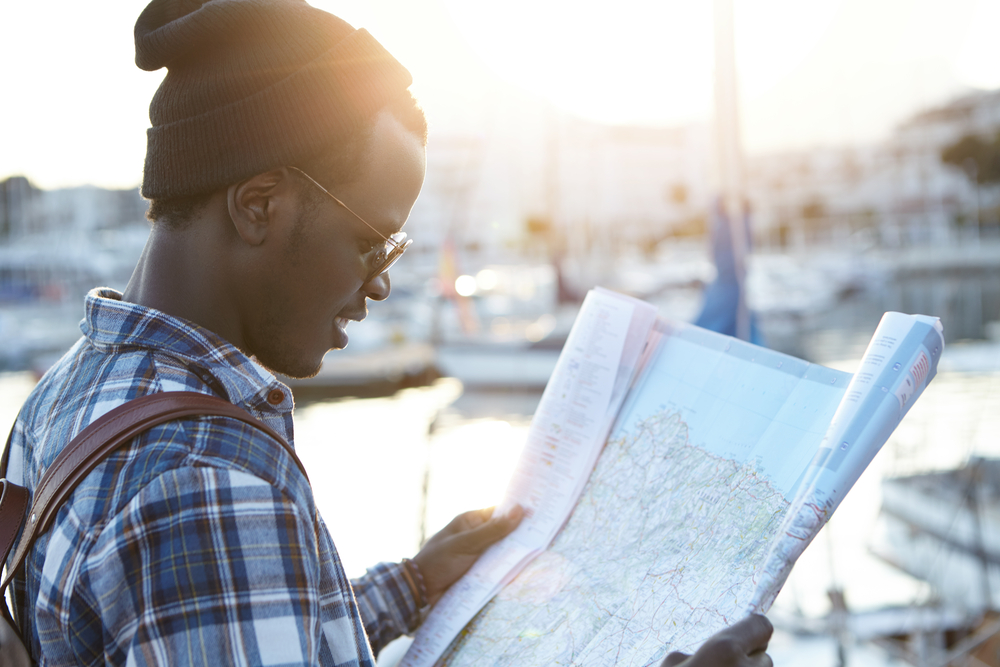Sound familiar? It’s the way most people travel—circling must-sees, creating air-tight itineraries, booking tours and hotels, practicing how to ask for the bathroom and haggle for souvenirs in the local language. And while it’s an easy and relatively low-effort way to see the world, this approach to trip-taking runs a serious risk: it can get boring.
The idea of a traveling rut might sound absurd. Pursuit of adventure and the desire to learn new things are what get most of us packing our bags in the first place. But it’s easy to lose this spirit once you’ve been on the road for awhile—another museum, another waterfall, another lumpy hotel mattress. Tourist traps aren’t just overpriced cliché vendors and halfhearted restaurants; they can become states of mind.
But what if you’re unable to rely on a lot of the traveling conventions that lead to such stalemates in the first place? One of the most non-traditional travelers I know is my brother. He’s severely dyslexic; activities most of us take for granted, like reading a guidebook and learning basic foreign phrases, are profoundly difficult for him. But instead of holing up at home, he’s learned to travel his own way. Sprung from linguistic disability, his atypical travel techniques have forced to give him to dig deeper and find alternatives to customary trip-taking—and the result has been travel experiences that are off-beat and out-of-the-mold.
Those of us who can, say, read a guidebook and converse fluently in foreign tongues can still make use of my brother’s dyslexic guide to traveling—I certainly have. What started for him as necessary coping tools have, for me, developed into a set of untraditional travel techniques that serve to get me out of ruts, off the beaten path and back into the spirit of adventure and wonder that got me on the road in the first place.
Got itchy feet? Scratch them with seven tips:

Travel Within Your Own Country
But there’s truly an intrinsic value in traveling through one’s native country—you learn more about your own culture. And because domestic travel does run the risk of being less adventuresome, you’re forced to dig, to delve deeper past that well-trodden tourist façade and find the real pulse of a place. Yeah, you could bum around Fisherman’s Wharf, but you could also take a walking tour of Mission District murals. You could mope through mind-numbing Times Square, or lay out a picnic blanket in picture-perfect Prospect Park. And while accommodations and transportation may indeed end up being more expensive than abroad, you’re likely to save money by avoiding overpriced tourist traps.
How do you find obscure and authentic things to do in a city not your own, domestic or abroad? The rest of the tips are a good guide.
>>read more about traveling locally

Make Use of Your Friends
Even if you aren’t able to travel home with your friends, they can supply you with invaluable insider tips. Fly from Mexico City to Oaxaca? A local will tell you to take the bus, spending a leisurely afternoon in pretty transfer point Puebla; he’ll also tell you to skip seedy Zipolte and park it at Puerto Angel.
The biggest advantage to this kind of travel is authenticity. When you travel with someone from a destination, or even merely get tips, you get to truly experience that place “like a local”—and minus the Rick Steves. You’ll find yourself anywhere from remote Mayan-dialect-speaking villages in Guatemala to illegal underground nightclubs in Berlin. If you’re headed back for a family occasion like a wedding or reunion, you’ll also get to experience the culture firsthand. You’ll gain access to the more intimate side of a place that other travelers rarely see—you might even see one of those stony, sever Moscow faces beam. What’s more, you have a built-in tour guide, someone who can explain any cultural quandaries or confusions.
The biggest “disadvantage,” for some, is lack of independence. You won’t really get a say in your itinerary or how long you stay at grandma’s house on beautiful Tuscan afternoon. This could drive some travelers nuts, but it also leads to the next tip…

Let Go of Your Itinerary
Start by leaving a couple days unscheduled, not making room reservations or buying advance bus tickets. Leave yourself open, and you’ll find that some of the best adventures on your trip will come from the random recommendation, the hasty map drawn on a scrap of paper, passed over a café table from one traveler to another. There’ll be regrets in any trip, places you wished you’d gotten to, but if you stay open to spontaneity, you increase your chances getting out of ruts and into the unusual.

Get Lost
When you’re not searching for specific street signs, you’re more open to see what’s in front of you: the sights, sounds, smells and overall uniqueness of a place. So meander through that medina, peruse that plaza, amble through those alleyways. Some of the best travel adventures end up being the ones you wander into, unplanned and unanticipated.

Communicate Creatively
But creative communication goes beyond just getting directions and ordering food. A lot of travelers fall into the trap of only meeting and forging friendships with other travelers, simply because they can’t exchange words with locals. Some studies have placed words at only 7% of what constitutes communication. So what makes up the rest? Intonation, body language, energy. A smile or kind gesture speaks volumes more than a hi-where-are-you-from conversation. Go out of your way make connections with locals, with or without the aid of language. A good way to do this? Bring little gifts from home: postcards, keepsakes, pencils. Even if you’re shy, you’ll get tired of carrying them around!

Get Off the Guidebook
You can start by leaving the guidebook at the hotel during day trips. Sketch yourself a rough map, jot down some notes and hit the town on your own. Yes, you’re likely to get lost, but that’s not a bad thing (do be sure to note any do-not-enter neighborhoods before venturing out; getting lost on the wrong side of the tracks can lead to big trouble). Work up to taking multi-day side trips sans guidebook. Eventually, you can go all the way to the extreme of leaving the book on the shelf, at home.
>>read about how to ditch the guidebook

Get Over Yourself
My brother misreads maps, stutters over the unfamiliar sounds of foreign words, sends home woefully misspelled, three-sentence emails that encapsulate his blunders, his peculiar experiences, his adventures.
Whenever you’re out of your comfort zone, away from home and immersed in the unfamiliar, you’re going to make mistakes. As a great jazz musician once said, if you’re not making mistakes, you’re not taking risks. An easy way to get stuck in a traveling rut? Stop taking risks.
Sure, mistakes make us look silly: we play ridiculous charades in an attempt to communicate across language barriers; we end up lost and confused in a foreign city; we dress wrongly or unwittingly make a social faux pas. But if we can laugh at ourselves, if we can get over the fear of looking absurd and making errors, we become more open to experiences, both on road and at home. And that’s what it’s all about anyway, right?
Read more about: